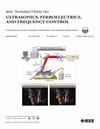微血管网络轴向速度自适应彩色多普勒成像。
IF 3.7
2区 工程技术
Q1 ACOUSTICS
IEEE transactions on ultrasonics, ferroelectrics, and frequency control
Pub Date : 2025-04-09
DOI:10.1109/TUFFC.2025.3559238
引用次数: 0
摘要
在功能超声成像中,定向滤波已被用于区分上升和下降的血流,然而,在使用基于定向滤波的彩色多普勒超声测速仪(iCD_US)时,它可能导致血流速度和方向的测量不正确。具体来说,在单向流动的频谱带宽同时延伸到负频域和正频域的情况下,定向滤波可能会错误地产生双向速度。本文提出了一种自适应彩色多普勒超声技术(aCD_US),该技术通过分析多普勒频谱的包络,然后自适应地使用全谱积分或基于方向滤波的方法来估计血流速度,从而解决了这一问题。通过数值模拟和各种流动条件下的模拟实验验证了所提出的aCD_US,在估计单向、双向和水平流动的轴向速度方面表现出优异的性能。值得注意的是,数值模拟表明,在大于-1 dB的信噪比下,aCD_US的方向精度超过90%,速度偏差小于15%。小鼠脑血流的体内实验进一步凸显了其优势,aCD_US在重建轴向血流速度图方面优于传统的彩色多普勒测速仪和iCD_US。aCD_US和vULM之间的定量比较显示,它们的轴向速度测量具有很强的整体相关性,Pearson相关系数为0.760 (p = 0.000)。这些结果证明了aCD_US在精确微血管网络速度量化方面的优势,以及它在研究和临床应用中提高微血管成像精度的潜力。本文章由计算机程序翻译,如有差异,请以英文原文为准。
Adaptive Color Doppler for Axial Velocity Imaging of Microvessel Networks
Directional filtering has been applied to distinguish between the ascending and descending flows in functional ultrasound imaging; however, it can lead to incorrect measurement of the flow speed and direction when using the directional filtering-based improved directional color Doppler ultrasound (iCD_US) velocimetry. Specifically, in cases where the frequency spectrum bandwidth of a unidirectional flow extends into both negative and positive frequency domains, directional filtering may erroneously produce bidirectional velocities. Here, we propose an adaptive color Doppler ultrasound (aCD_US) technique, which addresses this issue by analyzing the envelope of the Doppler spectrum and then adaptively using the whole spectrum integration or directional filtering-based approach to estimate the flow velocity. The proposed aCD_US was validated through numerical simulations and phantom experiments under various flow conditions, demonstrating superior performance in estimating axial velocities of unidirectional, bidirectional, and horizontal flows. Notably, numerical simulations showed that aCD_US achieved over 90% directional accuracy and less than 15% velocity deviation at signal-to-noise ratios (SNRs) larger than −1 dB. In vivo, experiments on mouse cerebral blood flow further highlighted its advantages, with aCD_US surpassing conventional color Doppler velocimetry and iCD_US in reconstructing axial flow velocity maps. The quantitative comparison between aCD_US and vULM shows a strong overall correlation in their axial velocity measurements, with a Pearson correlation coefficient of 0.760 ( ${p} =0.000$ ). These results demonstrate the advantage of aCD_US in precise microvessel network velocity quantification and its potential to advance microvascular imaging accuracy in both research and clinical applications.
求助全文
通过发布文献求助,成功后即可免费获取论文全文。
去求助
来源期刊
CiteScore
7.70
自引率
16.70%
发文量
583
审稿时长
4.5 months
期刊介绍:
IEEE Transactions on Ultrasonics, Ferroelectrics and Frequency Control includes the theory, technology, materials, and applications relating to: (1) the generation, transmission, and detection of ultrasonic waves and related phenomena; (2) medical ultrasound, including hyperthermia, bioeffects, tissue characterization and imaging; (3) ferroelectric, piezoelectric, and piezomagnetic materials, including crystals, polycrystalline solids, films, polymers, and composites; (4) frequency control, timing and time distribution, including crystal oscillators and other means of classical frequency control, and atomic, molecular and laser frequency control standards. Areas of interest range from fundamental studies to the design and/or applications of devices and systems.

 求助内容:
求助内容: 应助结果提醒方式:
应助结果提醒方式:


